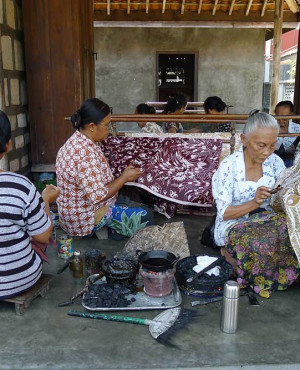
Jakarta – The Javanese, also known as the Orang Jawa, is the largest ethnic group in Indonesia. Their people are native to the island of Java where their traditions, culture, beliefs, and practices flourished through time. One of their notable cultural practices is the art of batik.
Origin and Development of Batik Cloths
The exact date of its origin is unknown, but the practice of batik of the Javanese people has been well-developed over hundreds of years. The term batik is of Javanese and Indonesian origin and describes a type of textile design that undergoes alternate fabric dyeing and waxing to create patterns in the cloth.
The use of batik was observed with the Sultan and his court’s particular use of the textile in Central Java around the regions of Yogyakarta and Surakarta (Solo). The practice gradually became a representation of the people’s rich culture and artistic inclination.
Art and Javanese Culture
In its early use, there were various prohibitions put on particular batik cloth designs. It was a tradition for each new sultan to make rules limiting how and when certain designs are to be worn. For a time, there was a decree that identified the designs as a symbol of one’s rank in society, therefore not allowing others to use certain batik prints.
For instance, during the Yogyakarta Sultanate of 1921 to 1939, Sri Paduka Sultan HB VIII prohibited the use of Semen Agung Sawat Lar, Semen Agung Sawat Garuda, Udan Liris, and Parang Rusak as these were supposed to be used exclusively by the royal family. These terms describe the designs of the textile; Parang Rusak refers to a broken knife/dagger motif, while Udan Liris refers to a drizzling rain pattern. The patterns represent various symbolisms such as power, justice, and even fertility.
With the patterns representing the distinct shared symbols of the Javanese community, it is good to have an idea of their language as well. Their Javanese language is Austronesian with similarities to Sundanese and Madurese. Javanese is divided into several regional dialects.
The language of the Javanese people reflects the status in society of the person being addressed. They have two speech levels: the nikko (with people of equal status) and kromo (with older people, people of higher status, or if the status is not known to the speaker). Understanding this nuance of their language gives you a better understanding of the sultan’s rule of only using particular patterns for royalty.
Batik Associations and Other Art Forms
The exact origin of the batik practice may not be clear, but given that Javanese royalty were famous advocates and patrons of the arts, it should not be a surprise that such a rich art form developed across the region.
The people’s artistic inclinations may have even influenced the creation of other art forms. For instance, the dalang (puppeteer) who are responsible for wayang kulit (leather puppets) served as a source of batik prints. The intricate designs on the puppets were later on painted to show a resemblance to clothing, which later on was put into actual practice through batik.
Aside from this textile tradition, the Javanese cultural heritage amounts to a variety of art forms: from the full gamelan orchestra to the traditional dances of bedhaya and serimpi. These societal associations give rise to the idea that within the Javanese community, the people are able to create their own sets of rules, practices, and culture. It is good to see that even to this day, even with the many changes in society and in the process, batik is a practice that remains alive and well among its people.
Image from Stephen Kennedy, https://www.flickr.com/photos/shkizzle/



